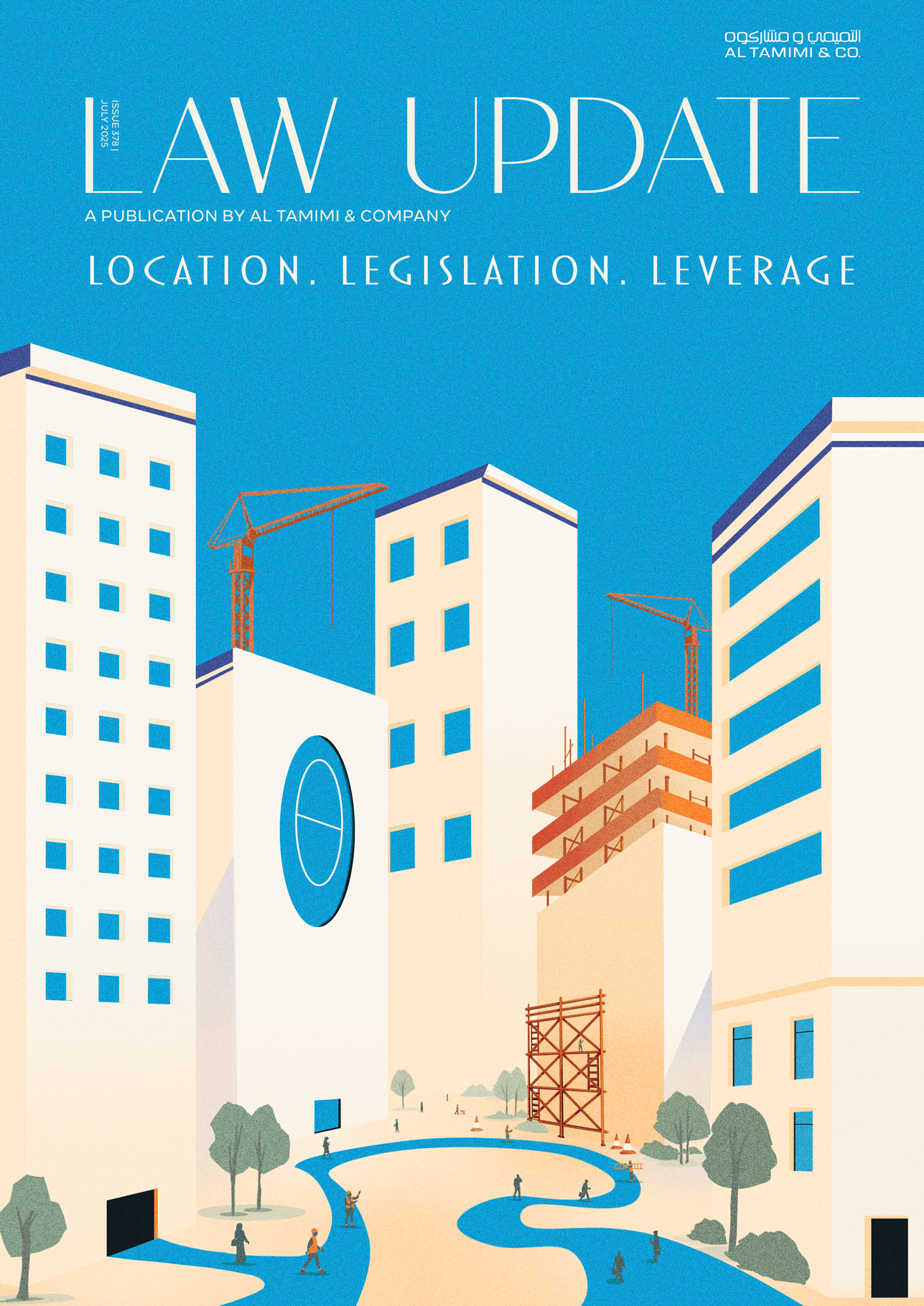Construction and the Technological Revolution
Leith Al-Ali - Senior Counsel - Construction and Infrastructure

Technology has over the years increasingly permeated nearly every aspect of our daily lives. It has also become the cornerstone of many industries, including healthcare, education, travel, communication and the environment – just a few of the sectors that have witnessed technology as a potent force for change and growth. Historically however the construction industry has had a relatively poor track record when it comes to embracing such change, lagging behind other sectors. This is why many are somewhat pessimistic as to the extent to which the industry is willing to adapt, capitalise on and benefit from some of the many advancements in technology that have been witnessed in recent years. This is especially surprising considering that there are more than USD 3 trillion in current or planned construction projects in the UAE alone – arguably providing stakeholders with innumerable opportunities to adopt and develop these new technologies in a manner that may ultimately help transform, not just their own projects but in the long term, the industry as a whole.
In this article we will briefly examine some of the notable recent technological developments within the construction industry and consider some of the implications for the sector embracing such innovation.
An Evolving Industry
In a recent report published by the World Economic Forum in cooperation with the Boston Consulting Group entitled “Shaping the Future of Construction: Future Scenarios and Implications for the Industry”, it was noted that the full scale digitalisation of the construction industry could save up to a staggering USD 1.7 trillion in construction and engineering costs globally over the course of the next ten years. This is in addition to the potential quality enhancements and time savings that stakeholders may benefit from as a result of using methods and practices which are more quality-driven and which require less time and cost to manage. These efficiencies can stem from a variety of different innovations including the utilisation of building information modelling (‘BIM’) and other similar software, 3D printing and modular construction, the use of block chain and data analytics, the use of robotics and other autonomous equipment as well as the increased prevalence of drones. Here we examine some of these technological advancements in greater detail.
- BIM: Building Information Modelling is a collaborative three dimensional model-based software allowing users to replicate various elements of a proposed construction project including elements of a project such as building terrain and utilities, incorporating computer-aided designs and technical specifications to enable stakeholders to visualise in 3D the physical and functional characteristics of a project. It can also enable developers, designers and contractors to evaluate how a building may deplete or wear over time, post-completion.
There are various potential benefits of utilising BIM, such as reducing the likelihood of having to re-work designs where there is a clash, thereby enabling designers and contractors to foresee any potential issues before they arise. As a result, BIM can enhance communication and co-ordination between project stakeholders which can ultimately help mitigate the risk of misunderstandings and defective works arising which, in turn, can further enhance co-ordination and the prospect of a project being completed and commissioned on time and in accordance with the employer’s original requirements. BIM can also have a significant cost impact, with reports suggesting it can help reduce overall project costs by at least 10 percent. - 3D Printing/Modular Construction: Although 3D printing is nothing new (having been around since the 1980s), it is only in recent years that the construction industry has ‘sat up’ and taken note of the various potential benefits utilising 3D printing can have for developers and contractors involved in construction projects. Recently, His Highness Sheikh Mohammed bin Rashid Al Makhtoum, UAE Vice President and Prime Minister, Ruler of Dubai, further re-emphasised the importance of this technology, directing that every new building in Dubai to be 25 percent 3D printed by the year 2025. By reducing the length of the supply chain and streamlining the procurement process, 3D printing can help save up to 50 percent of the overall construction cost. Standardised processes coupled with 3D printing can also be adopted to allow for construction of parts of the project off-site (a process known as modular construction) thereby reducing the lead time required for completion. In one example in Dubai, a 3D office building was reportedly printed in 17 days with assembly and construction completed within only two. With these efficiencies also comes the added potential benefit of being able to reduce the environmental impact construction can have, for example, by reducing the associated carbon dioxide footprint that is left when various parties, their equipment and machinery are involved in the often fragmented manufacture, supply, transportation and installation of materials. 3D printing coupled with modular construction will also allow companies to create visual representations of the proposed project at comparatively less cost and within a shorter time frame than is currently the case, while also enabling them to again more easily identify potential issues and ‘pinch points’ in the construction of a project, before they arise, thereby further allowing stakeholders the opportunity to potentially foresee and rectify such issues well in advance of the contractor even breaking ground.
- Blockchain/Data Analytics: Construction projects often involve vast amounts of data – from design development through to construction and post-completion. Timely reporting and data input can provide project stakeholders with an accurate, real time insight into site operations. Blockchain is one way in which this may be achieved. Blockchain is a special database comprising information including agreements, transactions and other information stored chronologically across a network of computers in the form of ‘blocks’. It is usually decentralised and therefore is often not managed by a central entity or authority. Each block is usually dated and time stamped with details of the author included, and once published cannot be changed. It is therefore an immutable and traceable record of everything that has taken place on a project as it cannot be manipulated or amended. Within the context of a construction project the use of blockchain and data analytics can help transform how we manage, record and interpret the vast amount of information, documentation and other data usually associated with such projects and ensures a transparent record of all interactions on a project can be maintained for stakeholders to refer to. This will enable the delivery of a more streamlined and integrated procurement process, reducing the fragmented manner in which information is often stored, managed and communicated especially on complex construction projects involving multiple parties. The transparent nature of blockchain can also ensure accountability where works or services have not been completed as agreed under the relevant contract. The use of blockchain may also complement the use of BIM by creating a single, robust source of information for stakeholders to utilise, spanning all aspects of a construction project.
- Drone Technology: The use of drone technology in the construction industry has risen exponentially in recent years. It is arguably one of the most utilised forms of technology, in an industry which is, as discussed earlier, seen to be lagging behind when it comes to the implementation of technological advancements. The ability to view the status of a construction project from an aerial vantage point and collect photographic data and information can provide stakeholders with a valuable, clear, real time view for the purposes of tracking progress. Drones can be equipped with various forms of technology including cameras, infrared and thermal sensors as well as GPS units further enhancing their ability to capture accurate, real time data of the construction site which can then be collated on specific software, analysed and interpreted, thus further strengthening the integrity of the site inspection process and ensuring the project completes in a timely and efficient manner. It should be noted that the use of drones in the UAE is regulated, at a federal level, by Federal Resolution No. 2 of 2015 regarding Light Air Sports Practice Regulations as well as the Civil Aviation Regulation Part VIII Subpart 10 which relates to the Operation of Unmanned Aerial Systems within the UAE. In Dubai for example, Dubai Law No. 7 of 2015 Concerning Airspace Safety and Security in the Emirate of Dubai, will also apply. Each of these laws clarifies the requirements and restrictions that must be adhered to by users and operators of such equipment, before they can be put into use. Drones are generally classified according to weight and the purpose for which they are intended to be used. Therefore, parties intending to use such equipment must ensure they pay close attention to and do not fall foul of the applicable federal and Emirate specific legislation, with the necessary approvals obtained, prior to using such equipment on a construction project.
- Robotics: The use of robotics in the construction industry is still very much in its infancy however its potential should not be overlooked. Robots may be utilised to undertake certain, conventionally man-operated tasks, such as brick laying, rebar tying and other manual-intensive labour or tasks of a repetitive nature thereby allowing project and contractor resources to be directed elsewhere if needed. Their real value is yet to be seen. The unpredictable and obstacle riddled nature of a construction site and robots’ inability to adapt to real-time variables on a work site to further production and productivity without compromising safety or quality, are just some of the challenges which few robots developed to date, have been able to overcome. With robotics however it is very much a case of ‘watch this space’.
Implications for the Future
As technology continues to evolve and the construction industry tries to keep pace with this evolution, stakeholders must ensure they carefully consider the implications from both a legal and commercial perspective.
The use of BIM and blockchain will invariably require the relevant overarching contractual frameworks to be modified and updated to include bespoke provisions with respect to each parties’ rights and obligations, for example, regarding the use, management and implementation of BIM technology on a construction project. In the UK, BIM level 3 (which is essentially a more advanced form of BIM whereby data can be accessed by a broader cohort of project stakeholders and shared both within and across different projects in order to improve efficiency and drive collaboration and innovation), poses a number of legal challenges. For example, it is as yet unclear exactly what contractual changes are needed in order to address the potential risks associated with its use, what standard of care must be adopted when preparing elements of the BIM model (an absolute duty or one that is subject to reasonable skill and care), who is liable for mistakes in the BIM model, when would a party’s contractual limitation period in respect of information provided in the BIM model actually come to an end, to what extent do contractual insurance requirements need to be amended to ensure insurance coverage extends to and will respond in the event of a claim arising out of the use of BIM and furthermore if the intellectual property and licensing provisions (often included within construction contracts and consultancy services agreements) need to be revisited to allow a BIM model to be used for the purpose for which it was intended, including for example post-completion by the owners and/or users of the property to which it relates.
It should also be recognised that many of the forms of technology identified in this article are in a state of flux, constantly being developed to ensure that they are at the forefront of the industry. Contracts which address parties’ obligations with respect to the use of any of these forms of technology should therefore be periodically revisited in order to ensure they accurately reflect and address the current technical, regulatory and legal requirements of the jurisdiction in which they are being implemented and moreover such that any associated risks are apportioned between the contracting parties accordingly.
The use of drone technology, for example, may arguably have privacy implications with respect to the rights of adjoining neighbours and properties – an issue which may need to be considered especially if drones are being utilised in heavily populated residential areas where nearby inhabitants may be overlooked.
The gradual increased prevalence of robotics may result in certain labour-intensive roles eventually becoming redundant as contractors seek to save on the cost of employing certain types of labour. At the same time this may present opportunities for individuals and companies to upskill because any such equipment will also need skilled manpower to ensure their continued effective operation and maintenance.
In summary, it is important that stakeholders in the construction sector devote sufficient time and resources towards evaluating if and how new technologies that are being used and developed in the industry might impact them and furthermore how such technology can be best utilised in order to enhance productivity, quality, competitiveness and ultimately profitability, ensuring they are able to keep up with and remain a part of the industry’s evolving landscape for many years to come.
Al Tamimi & Company’s Construction & Infrastructure team regularly advises on all elements of the construction procurement process. For further information please contact Lyndon Richards (l.richards@tamimi.com) or Leith Al-Ali (l.alali@tamimi.com)
Stay updated
To learn more about our services and get the latest legal insights from across the Middle East and North Africa region, click on the link below.






